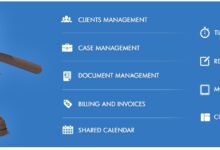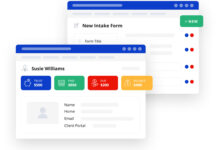CRM for Law Firm: Streamlining Legal Practice
CRM for Law Firm: In today’s competitive legal landscape, efficient client management is paramount. A well-implemented CRM system can significantly enhance a law firm’s operational efficiency, improve client communication, and ultimately boost profitability. This exploration delves into the multifaceted benefits of CRM adoption for law firms of all sizes, addressing key features, integration strategies, and crucial compliance considerations.
From streamlining case management and workflow optimization to leveraging data analytics for informed decision-making, a CRM system empowers legal professionals to focus on what matters most: providing exceptional client service and achieving positive outcomes. This guide offers practical insights and actionable strategies to help law firms harness the full potential of CRM technology.
Defining CRM Needs for Law Firms
Effective client relationship management (CRM) is crucial for law firms of all sizes, impacting profitability, efficiency, and overall success. However, the unique demands of the legal profession present specific challenges that require a tailored CRM solution. This section explores these challenges and outlines the key features a CRM should possess to effectively serve a law firm’s needs.
Unique Challenges in Managing Client Relationships for Law Firms
Law firms face several unique challenges in managing client relationships. The sensitive nature of client information necessitates robust security measures. Complex case management requires tracking numerous details, deadlines, and communications across multiple individuals. Furthermore, maintaining compliance with legal and ethical regulations is paramount, demanding meticulous record-keeping and accessibility. Finally, the need to bill clients accurately and efficiently adds another layer of complexity. These challenges highlight the importance of a CRM system designed specifically for the legal industry.
Key CRM Features for Law Firms
A CRM system for a law firm must offer several key features to address the challenges outlined above. These include secure data storage and access control, comprehensive case management capabilities with detailed tracking of tasks, deadlines, and communications, integrated document management, robust reporting and analytics for performance tracking and billing, and seamless integration with other essential legal software. Furthermore, client portals allowing for secure client communication and document sharing are highly beneficial, enhancing transparency and improving client experience. Finally, features supporting compliance with relevant regulations are essential.
CRM Usage Across Different Law Firm Sizes
Small law firms might prioritize features focused on client communication, case tracking, and basic billing. A simple CRM with intuitive interface and straightforward reporting would suffice. Medium-sized firms might require more advanced features, including integrated document management, team collaboration tools, and more sophisticated reporting capabilities for better performance analysis and resource allocation. Large firms typically need comprehensive solutions that handle complex workflows, integrate with multiple systems, and provide advanced analytics for strategic decision-making, often incorporating features for managing multiple offices and teams.
Comparison of CRM Systems for Law Firms
| Name | Key Features | Pricing Model | Target Firm Size |
|---|---|---|---|
| Clio Manage | Case management, time tracking, billing, client communication portal, document management | Subscription-based, tiered pricing | Small to large firms |
| MyCase | Case management, client communication, document management, billing, task management | Subscription-based, tiered pricing | Small to medium firms |
| PracticePanther | Time tracking, billing, case management, client portal, reporting | Subscription-based, tiered pricing | Small to medium firms |
Client Management and Communication
Effective client management and communication are paramount for law firms. A robust CRM system streamlines these processes, fostering stronger client relationships and improving operational efficiency. By centralizing client information and integrating communication tools, law firms can enhance their responsiveness and overall service delivery.
A well-implemented CRM system acts as the central hub for all client interactions throughout the legal process, from initial consultation to case closure. This ensures consistent communication and prevents crucial information from being lost or overlooked. This leads to improved client satisfaction and ultimately, stronger business outcomes.
Managing Client Interactions Throughout the Legal Process
A CRM allows for detailed tracking of each stage of a client’s case. From the initial intake form, through various stages of legal proceedings, to final resolution, all interactions and documents are meticulously recorded and easily accessible. This chronological record provides a complete history of the client’s case, enabling seamless handoffs between team members and maintaining consistency in communication. For example, a lawyer can instantly access the client’s complete file, including emails, notes from meetings, and relevant documents, ensuring they are fully briefed before a court appearance or client meeting. This significantly reduces the time spent searching for information and minimizes the risk of overlooking crucial details.
Improving Communication Efficiency and Reducing Errors
CRM systems enhance communication efficiency by centralizing all client communication in one place. Instead of relying on scattered emails, phone calls, and paper files, all interactions are logged within the CRM, creating a single source of truth. This minimizes the chance of missed communications or conflicting information. For instance, if a client emails an update, it’s automatically logged against their case file, alerting the relevant team members and ensuring a prompt response. Automated reminders for deadlines and follow-ups further reduce the likelihood of errors and delays. This organized approach minimizes the risk of missed deadlines or forgotten tasks, leading to smoother case management.
Organizing Client Information Within a CRM System
Organizing client information effectively is key to efficient case management. A CRM system facilitates this by providing a structured framework for storing client data, including contact details, case details, and associated documents. Contact information (name, address, phone number, email) is readily accessible, allowing for quick and easy communication. Case details (case number, status, deadlines, assigned attorney) are clearly outlined, providing a comprehensive overview of the case’s progress. Documents (contracts, pleadings, correspondence) are securely stored and easily retrievable, eliminating the need for extensive file searching. The system often allows for customized fields to cater to specific firm needs, ensuring all relevant information is readily available.
Benefits of Integrated Communication Tools
Integrated communication tools within a CRM are crucial for seamless client interaction. Having email, phone, and text messaging capabilities within the CRM improves responsiveness and enhances the client experience.
- Improved Response Times: Direct access to communication channels within the CRM allows for immediate responses to client inquiries, enhancing client satisfaction.
- Enhanced Collaboration: Internal communication is streamlined through shared access to client information and communication logs, facilitating efficient teamwork.
- Centralized Communication History: A complete record of all communications with a client is readily available, providing context and improving the quality of future interactions.
- Automated Reminders and Notifications: The system can automatically send reminders for deadlines, appointments, and follow-ups, minimizing the risk of missed tasks.
- Improved Client Relationship Management: Consistent and efficient communication fosters stronger client relationships, leading to increased client loyalty and referrals.
Case Management and Workflow Optimization
A robust CRM system significantly enhances a law firm’s ability to manage cases efficiently, improving overall productivity and client satisfaction. By centralizing case information and automating various tasks, a CRM streamlines workflows and reduces the risk of missed deadlines or overlooked details, leading to better outcomes for both the firm and its clients.
Streamlining Case Management Processes with CRM
A CRM system acts as a central repository for all case-related information, eliminating the need to search through disparate files and emails. This centralized approach allows legal professionals to quickly access crucial details such as client information, case history, deadlines, documents, and communication logs, all in one place. This immediate access to information facilitates faster decision-making and reduces the time spent on administrative tasks, freeing up valuable time for more strategic work. For example, a lawyer can instantly review a client’s complete file, including correspondence and previous legal actions, before a court appearance, ensuring they are fully prepared.
Advantages of CRM for Task Assignment, Deadline Tracking, and Progress Monitoring
CRMs offer powerful tools for managing tasks, deadlines, and progress. Features like automated reminders, task assignment functionalities, and progress tracking dashboards provide a clear overview of the case’s status. This allows for proactive management of deadlines, ensuring timely completion of tasks and preventing delays. For instance, a CRM can automatically alert a paralegal when a document is due for filing, ensuring timely submission and avoiding potential penalties. Similarly, progress tracking allows managers to monitor team performance and identify potential bottlenecks, allowing for timely intervention and resource allocation.
Improving Collaboration Among Legal Professionals with CRM
CRMs foster seamless collaboration among legal professionals by providing a shared platform for communication and document sharing. Features like integrated messaging, shared calendars, and collaborative document editing ensure everyone is on the same page, promoting efficiency and reducing misunderstandings. For example, multiple lawyers working on a complex case can share notes, documents, and strategies within the CRM, facilitating effective teamwork and ensuring consistent communication with the client. This reduces the reliance on email chains and enhances overall team cohesion.
Step-by-Step Guide to Implementing a CRM System for Case Management
Implementing a CRM system for case management requires a structured approach. A successful implementation involves careful planning and execution. The following steps outline a practical approach:
- Needs Assessment: Thoroughly assess the firm’s specific case management needs and identify the key functionalities required from a CRM system. This includes considering the size of the firm, the types of cases handled, and the existing workflows.
- CRM Selection: Research and select a CRM system that aligns with the firm’s needs and budget. Consider factors such as scalability, integration capabilities, and user-friendliness.
- Data Migration: Migrate existing case data into the new CRM system. This process requires careful planning and execution to ensure data accuracy and integrity.
- System Configuration: Configure the CRM system to match the firm’s specific workflows and processes. This may involve customizing fields, creating workflows, and setting up user permissions.
- User Training: Provide comprehensive training to all users on how to effectively utilize the CRM system. This will ensure adoption and maximize the system’s benefits.
- Ongoing Monitoring and Optimization: Regularly monitor the system’s performance and make adjustments as needed to optimize its effectiveness. Gather feedback from users and make necessary improvements to ensure the CRM system remains a valuable asset to the firm.
Reporting and Analytics
A robust CRM system for a law firm is not just about storing client data; it’s a powerful tool for generating insightful reports that reveal trends, identify areas for improvement, and ultimately drive firm growth. By leveraging the data collected within the CRM, law firms can gain a comprehensive understanding of their performance, allowing for data-driven decision-making.
The ability to generate insightful reports on firm performance is a key benefit of using a CRM. This data provides a clear picture of efficiency, profitability, and overall success. Understanding these key metrics allows for proactive adjustments to strategies and resource allocation.
Key Metrics for Law Firm Performance Tracking
Tracking the right metrics is crucial for effective performance analysis. These metrics provide a quantifiable measure of success across various aspects of the firm’s operations. Regular monitoring of these key indicators allows for early identification of potential problems and opportunities for optimization.
- Client Acquisition Cost (CAC): This metric measures the total cost of acquiring a new client, including marketing expenses, sales efforts, and other related costs. A lower CAC indicates higher efficiency in client acquisition.
- Case Win Rate: This metric reflects the percentage of cases the firm successfully wins. A high win rate demonstrates expertise and effectiveness in legal representation.
- Average Revenue Per Client (ARPC): This metric calculates the average revenue generated per client over a specific period. A higher ARPC signifies the firm’s ability to generate higher revenue from its client base.
- Matter Resolution Time: This metric tracks the average time taken to resolve a case. Reducing this time improves efficiency and client satisfaction.
- Client Retention Rate: This metric measures the percentage of clients retained over a specific period. High retention rates indicate strong client relationships and satisfaction.
Actionable Insights from CRM Analytics
The data gathered within a CRM system can be analyzed to provide actionable insights that directly impact the firm’s strategies and operations. These insights can lead to significant improvements in efficiency, profitability, and client satisfaction.
For example, analyzing the CAC can reveal which marketing channels are most effective and which are draining resources. A low case win rate might indicate a need for improved legal strategies or additional training for legal staff. Low ARPC could suggest the need to adjust pricing strategies or explore opportunities to offer additional services to existing clients. Long matter resolution times might indicate workflow inefficiencies or a need for additional staffing. Low client retention rates could signal problems with client communication or service delivery.
CRM Dashboard Visualization of KPIs
Imagine a CRM dashboard displaying key performance indicators (KPIs) using a combination of charts and graphs.
The dashboard’s central area features a large, circular gauge chart displaying the current Case Win Rate, with a green arc indicating the target percentage and a red arc indicating the danger zone. Below this, a bar chart compares the ARPC for the current month against the previous three months, highlighting trends in revenue generation. To the right, a line graph tracks the Client Acquisition Cost over the past year, showing seasonal variations and the impact of marketing campaigns. Smaller, square boxes on the bottom display quick numerical updates for key metrics like Matter Resolution Time and Client Retention Rate, showing current averages and comparing them to monthly goals. The overall color scheme is clean and professional, using a combination of blues and greens to convey a sense of calm and efficiency. The dashboard is designed to be easily understood at a glance, allowing for quick identification of trends and areas requiring attention. Each visual element is interactive, allowing users to drill down for more detailed information.
Security and Compliance
Choosing a CRM for a law firm requires careful consideration of security and compliance, given the sensitive nature of client data handled. Data breaches can lead to significant financial losses, reputational damage, and legal repercussions. Therefore, selecting a system with robust security features and adherence to relevant regulations is paramount.
Critical Security Considerations for Law Firm CRMs
Security should be a top priority when evaluating CRM options. Factors to consider include data encryption both in transit and at rest, access controls with granular permission settings for different user roles (e.g., attorney, paralegal, administrative staff), multi-factor authentication (MFA) to prevent unauthorized access, regular security audits and penetration testing to identify vulnerabilities, and a comprehensive disaster recovery plan to ensure business continuity in case of system failures or cyberattacks. The CRM provider’s security certifications (e.g., ISO 27001, SOC 2) should also be verified. Consider the physical security of the provider’s data centers as well.
Compliance Requirements for Storing and Managing Client Data
Law firms must comply with various regulations when storing and managing client data in a CRM. These regulations vary depending on jurisdiction and the type of data being handled, but commonly include HIPAA (for healthcare information), GDPR (for EU resident data), CCPA (for California resident data), and state-specific data privacy laws. Compliance necessitates adhering to data minimization principles (only collecting necessary data), implementing appropriate data retention policies, and providing clients with clear and accessible privacy notices. The CRM should offer features that facilitate compliance, such as data masking and audit trails.
Ensuring Data Privacy and Confidentiality within the CRM System
Maintaining data privacy and confidentiality requires a multi-faceted approach. This includes implementing strong access controls, restricting data access to authorized personnel only, regularly reviewing and updating user permissions, employing data encryption techniques to protect data at rest and in transit, and conducting employee training on data security best practices and compliance regulations. The use of anonymization or pseudonymization techniques for sensitive data where possible can further enhance privacy. Regular security assessments and penetration testing should be conducted to identify and address potential vulnerabilities proactively. A well-defined incident response plan is crucial to effectively handle any security breaches.
Checklist for Ensuring CRM Security and Compliance
Before implementing a CRM, a thorough checklist should be completed to ensure security and compliance. This checklist should include:
- Assessment of current and future compliance needs (e.g., GDPR, HIPAA, CCPA).
- Review of the CRM provider’s security certifications and policies.
- Verification of data encryption methods used by the CRM (both in transit and at rest).
- Implementation of strong access controls and multi-factor authentication.
- Development and implementation of data retention and deletion policies.
- Creation of a comprehensive incident response plan.
- Regular security audits and penetration testing.
- Employee training on data security and compliance.
- Documentation of all security and compliance measures.
Final Conclusion
Ultimately, integrating a CRM system into a law firm’s operations represents a strategic investment in efficiency and growth. By carefully selecting a system that aligns with the firm’s specific needs and proactively addressing security and compliance concerns, legal professionals can unlock significant improvements in client relationships, case management, and overall firm performance. The benefits extend beyond simple organization; a robust CRM empowers data-driven decision-making, fostering a more proactive and profitable legal practice.


